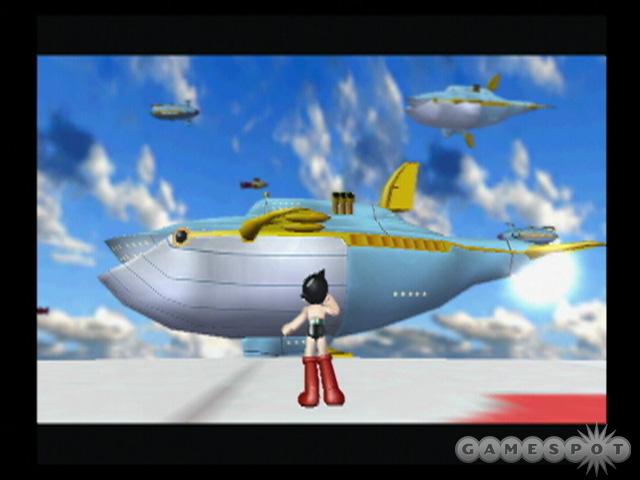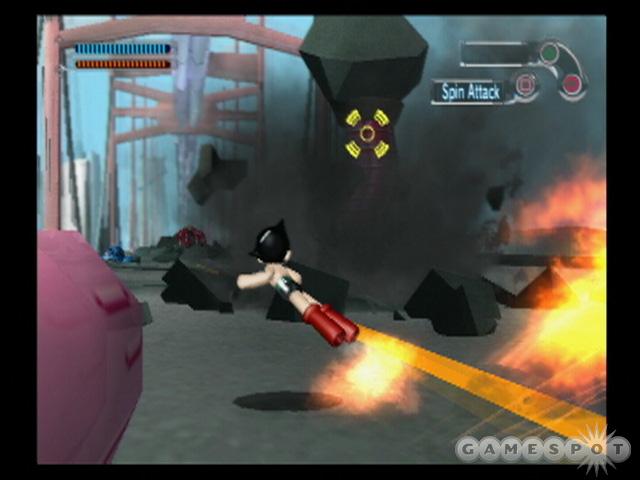Astro Boy Updated Hands-On Impressions
We check out the US version of Astro Boy's PlayStation 2 adventure.
Astro Boy is the upcoming third-person action game from Sega that puts you in the role of the classic anime hero Astro Boy, Osamu Tezuka's pint-sized robot with a heart of gold. The Sonic Team-developed game, released this past March in Japan, is part of a revival for the character, who has seen a new animated series as well as a Game Boy Advance game this year. While we looked at the import PlayStation 2 game at the time of its release, we recently got our hands on the US version of the game to see how it has made the trip.

The game uses a good chunk of footage from the current animated series upon which it's based. For the uninformed, Astro Boy is the mechanical protector of Metro City. The eager-to-please robot is a regular Swiss Army knife of usefulness, sporting special abilities such as rocket feet that let him fly, supersonic hearing, X-ray vision, varied armaments, and a powerful computer brain. (Think Superman, only smaller and lacking the annoying weakness to kryptonite.) However, behind his sunny disposition lies a tragic origin that will play a major role in Astro's current life. What that is and how it plays out are for you to discover over the course of the game.
The gameplay remains unchanged, and it is divided between flight and ground sequences that will vary depending on the mission. Your missions will be dictated by the game's story, which plays out in a basic linear fashion with a few detours, such as minigames to play and special cards to collect for Astro's sister Zoran. You'll interact with a host of friends and foes right out of the cartoon, and you'll be treated to plenty of the aforementioned cinematics as you move along with the narrative. You'll travel to the different locations via portals you'll find in the main city, which acts as a hub. As you progress through the game, Astro's varied abilities will unlock, giving the game a Mega Man-esque feel and allowing you to perform even more amazing acts. One thing to note is that the game's boss battles, each a little more spectacular than the last, are easily the coolest aspect of the game and are arguably the best part of the experience.
The control in the game is solid for both types of gameplay. You'll move Astro around with the left analog stick, jump with the X button, and punch with the square button. Once you earn your digibeam, Astro's finger laser, the circle button will shoot it. The triangle button will fire off Astro's arm cannon, a chargeable blaster that can take out bunches of enemies with ease. The square button is one of three context-sensitive buttons you'll see in the upper right-hand corner of the screen, whose use will vary with the situation. The R1 button will let you trigger Astro's X-ray vision, which is handy for finding enemies or clues on certain missions. Taking flight is as easy as jumping twice or pushing up with the right analog stick. When you're in the air, the game feels a bit like Zone of the Enders, and the game's lock-on feature, which uses the L1 button, makes attacking enemies a breeze. The game's camera can be manipulated in a few ways. The L2 and R2 buttons rotate your view left or right, while the select button will switch you to a first-person view.

The overall presentation of the game is solid, with a few changes from the original Japanese release. The graphics have been tweaked a bit, but the game still has some of the same fundamental rough spots with the camera and frame rate. The cartoony visuals do a good job of preserving the look and feel of Astro's 2D adventure while bringing them into 3D. The camera is still somewhat problematic in spots, such as in some of the cramped indoor environments and when you're fighting multiple enemies--but it isn't broken. The frame rate is still inconsistent in the larger open spaces that you'll be zipping through as well as when there's a lot of action onscreen, such as battles. However, that said, the frame rate doesn't seem to bog down quite as much as in the Japanese game. The audio in the game makes use of English voices, which are faithful to their cartoon counterparts, and localization that is on par with your average cartoon. The in-game music is a good assortment of cheerfully upbeat tunes and faster-paced tracks that suit the battles nicely.
Although still a little rough around the edges, Astro Boy for the PlayStation 2 should be a solid action game, best suited for younger gamers and avid fans of the tiny, pompadour-sporting robot. The graphics are faithful to the cartoon, though they're a bit underwhelming given Sonic Team's usually high standards, thanks to a problematic camera and frame rate inconsistencies. The gameplay, while linear, is solid and fun on the whole, and the boss fights stand out as being especially fun. If you fall into any of the above categories, you'll want to check out Astro Boy when it ships this August for the PlayStation 2.
Got a news tip or want to contact us directly? Email news@gamespot.com
Join the conversation